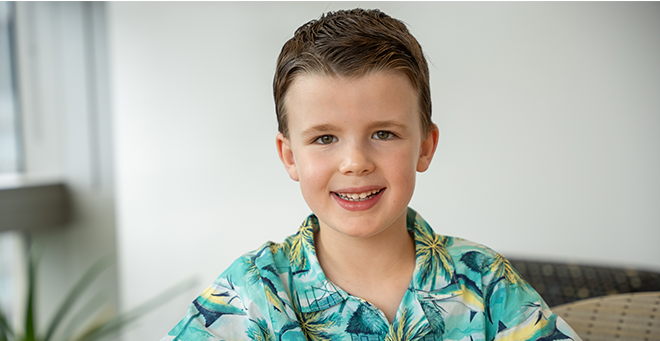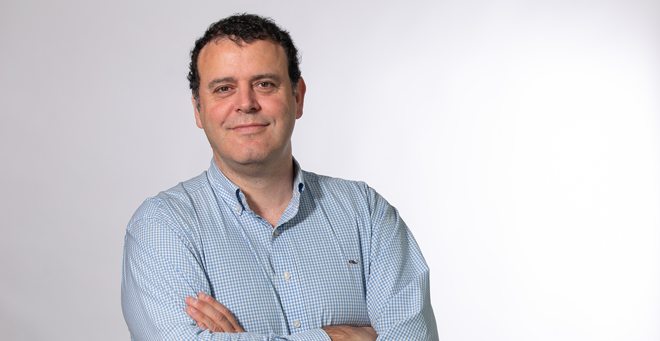
A family from Ottawa, Canada, seeking a cure for spastic paraplegia type 4 (SPG4), a rare genetic neurological disorder that progressively weakens and causes spasticity in the legs, recently visited UMass Chan Medical School to meet researchers who are working toward a gene therapy for the disease, for which there is no cure.
Parents Anna and Richard Laidlaw are partnering with Blu Genes Foundation to raise money to support gene therapy research at UMass Chan led by Heather Gray-Edwards, DVM, PhD, assistant professor of radiology in the Horae Gene Therapy Center; and Miguel Sena-Esteves, PhD, associate professor of neurology, member of the Horae Gene Therapy Center and director of the Translational Institute for Molecular Therapeutics.
Dr. Sena-Esteves said the emerging role of the translational institute is to develop gene therapies for diseases that corporations won’t take on because they’re not “commercially viable” because there are too few potential patients with a given rare disease and gene therapy may require only one dose.
“So, we think that it falls on us academics to develop these therapies and figure out a pathway to bring these drugs to market,” said Sena-Esteves. “The FDA has been extremely helpful to us, and we work with them very closely.”
Seven-year-old Jack Laidlaw was diagnosed with SPG4 in December 2023, a few years after his parents noticed his toes pointed inward when he walked. Their pediatrician told them this can be normal, and most children grow out of it. But when it hadn’t improved a year later, the Laidlaws took Jack to a physical therapist who, after a year of therapy with no improvement, suggested there may be an underlying neurological condition.
When a neurologist analyzed genetic tests, the Laidlaws found a diagnosis. But that diagnosis of hereditary SPG4 was the beginning of a new journey in search of a cure.
The quest is a family affair involving Anna’s parents, Ralph and Suzie Nilson—both retired health researchers—and Jack’s younger brothers, Scott, age 5, and Tom, age 2, who came along to the UMass Chan visit.
Scouring the internet for experts who could help them, the Laidlaws connected with child neurologist Darius Ebrahimi-Fakhari, MD, PhD, at Boston Children’s Hospital, who enrolled Jack in a natural history study for early onset hereditary spastic paraplegia. The study aims to delineate the core clinical, imaging and molecular features of the disease, to facilitate early diagnosis and help identify biomarkers and novel targets for therapy.
Dr. Ebrahimi-Fakhari told the Laidlaws there was research being done on SPG4 at UMass Chan.
The genetic mechanism of SPG4 is not fully understood. Currently it is unclear whether the disease is caused by not having enough of the normal protein in the cell, or because the mutant protein is toxic. The labs of Dr. Gray-Edwards and Sena-Esteves are devising a gene therapy strategy that should work regardless of the mechanism, which could take many years to pin down.
Because the genetic mechanism is unknown, scientists have designed several versions of adeno-associated virus (AAV) vectors: one using an element that goes after the RNA already present in the cells (normal and mutant copies) and another that will make an RNA that tells the cell how to make the normal protein, which is also resistant to the little molecule (microRNA) they’re making to silence the endogenous genes, Sena-Esteves explained.
“There are different vectors that we’re testing that have different expression levels of the microRNA to silence protein production from the endogenous genes, and different expression levels of the protein from the AAV vector so that we can find the sweet spot, and those are the things that will change,” said Gray-Edwards. “It may not actually be a mutant protein doing a bad thing at all, it may just not be enough of the protein. And if that’s the case, then we need to make sure we have appropriate expression levels with the protein.”
The proof-of-concept studies in animal models combined with the natural history study being done at Boston Children’s Hospital will be the basis for a pre-Investigational New Drug application to the FDA. This step is necessary to obtain feedback from FDA on the path to a phase I/II clinical trial.
Researchers who visited with the Laidlaws said they were inspired by the family’s efforts.
“We care about rare diseases,” said Sena-Esteves. “If there’s someone who needs help and we believe we can make a difference, working with them is what we do.”



